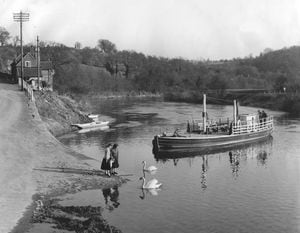Flashback – January 20
January 22, 1972, was a ferry significant date for the river village of Arley, south of Bridgnorth.

On that day centuries of history came to an abrupt end as the village's ferry over the River Severn crossed the river for the last time, being superseded by a footbridge which had been built at a cost of £43,500.
The ferry at Upper Arley had crossed there for more than 600 years, and was first mentioned in records in the 1300s.
It survived to be one of the last working ferries on the river, linking the two halves of the village.
Worcestershire County Council felt the bridge would provide a much better service than the ferry as it would be open 24 hours a day and would not be subject to closure by floods.
And at some times of the year few people used the ferry, making it a heavy financial burden.
Despite the large capital cost of the bridge, the council surveyor of the day, Mr W.R. Thomson, said it would pay off over the years.
The ferry was operated in two shifts a day for 16 hours, according to a 1970 story.
Another factor was that the ferry had lost about £20,000 in the last 13 years of its operation.
It crossed the river along a rope or chain stretched from bank to bank, the application of the rudder harnessing the power of the river’s current to propel it across.
The bridge which replaced it had been expected to be ready for use by the end of 1970, but work was held up by a national steel shortage. Ironically during construction work the steel for the bridge was carried across the river by the ferry.
The last ferryman, with 32 years’ service, was Bert The Boatman, Bert Evans, who would help the vessel traverse the river using a long punt pole.
On the dramatic night of August 26, 1957, the Hampton Loade ferry upstream broke from its moorings and Bert, with the help of a policeman and two others, got the Arley Ferry broadside across the river, risking their lives to stop the runaway. He received a bravery award.
The ferry at Arley was temporarily replaced by ex-Army landing craft in the post-war period because, according to Josephine Jeremiah’s book The River Severn, it became rotted.
The landing craft were bolted together, but this did not make villagers any the less concerned. The book says a new ferry came into operation on June 24, 1952.
When closure loomed, it was suggested Arley ferry could be kept as a tourist attraction by the Severn Valley Railway. The county council was also approached by individuals interested in preserving the boat.
In the event it was later moored in Bewdley and used as a landing stage for pleasure boats, but was washed away in floods in December 1994.
According to one account the ferry broke in two, with half overturning at the mooring, and the rest passing under Bewdley bridge and coming to rest near the town's bandstand.
However Bewdley resident David Griffiths, who salvaged the prow of the historic ferry and installed it as a water feature in the garden of his cottage, says that account is incorrect.
"It was moored by the Cock & Magpie and in a terrible state of repair, and sank. The people who owned it could not afford to get it out of the river. People cut it up with chainsaws. It did not break in half – that's a myth," said David.
The prow is still in his front garden as part of a fish pool feature, and is accompanied by an information board which was done by his wife Penny.
"Somebody also donated the anchor. We made a garden feature out of the prow and then somebody phoned me up and said my dad has got the anchor, would you like it as he is going into a retirement home."
All these years on, what little remains of the Arley ferry continues to generate interest.
"We have lots of school children from Birmingham come round. They have never heard of this sort of thing before and the schoolteachers are brilliant. They will stand and read the sign, look at the ferry, and explain to the children exactly what it was.
"This is history. When Arley ferry was in operation it took schoolchildren to the school on the other side of the river. Even though we only have a little bit of the ferry in our garden, it's still attracting children. The ferryman would be very proud of what we are doing."




